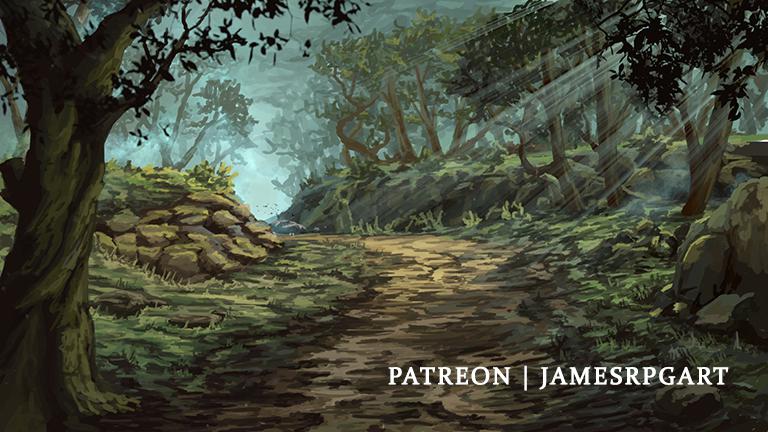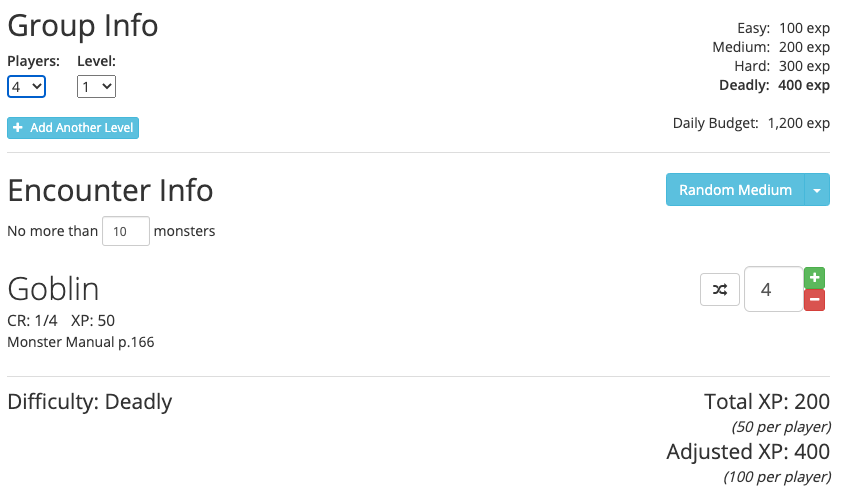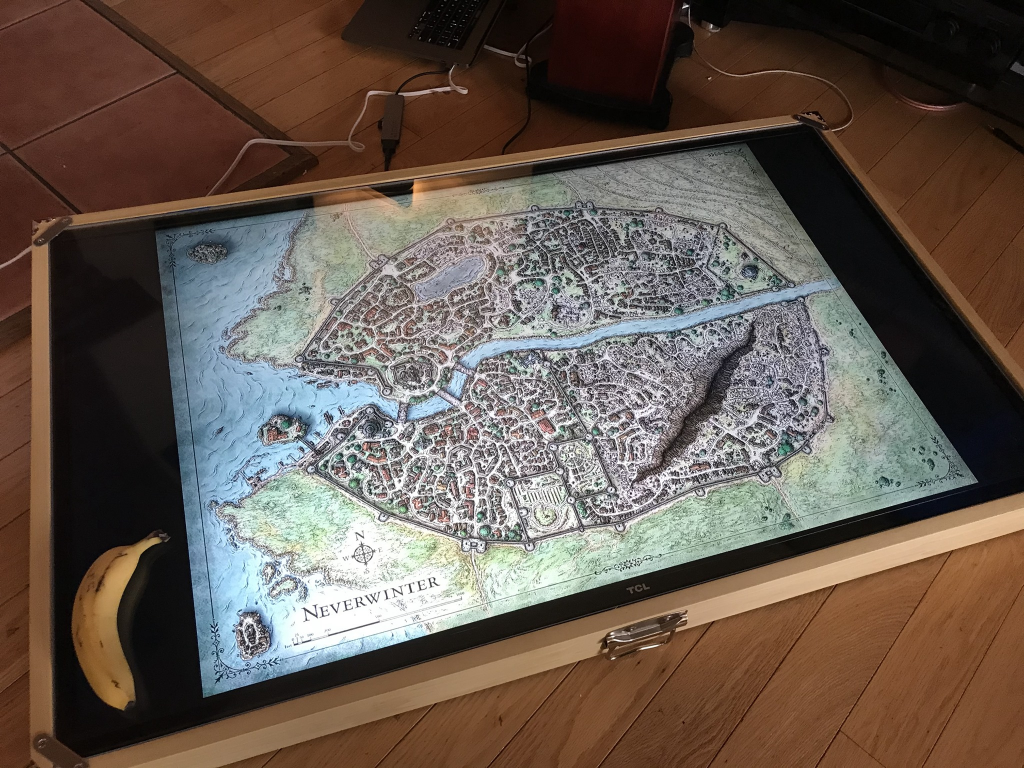
This is part 2 of a 3 part series covering Act 1 of Lost Mines of Phandelver. Consider checking out Part 1: Before the Goblin Ambush for more info about setting the scene and generating bonds for the player characters in your party. Please stay tuned for Part 3 on Cragmaw Hideout!
Since the goblin ambush is often the first combat encounter many GMs ever run, it’s important to have a good handle on the rules as they pertain to this particular encounter. Since this is an ambush, concepts such as active vs. passive perception, stealth, and surprise will come into play. Also, since goblins will be behind trees on an embankment, concepts such as cover and difficult terrain are sure to come into play as well. In addition to reviewing combat mechanics as they would apply to this ambush, we’ll talk about adjusting the encounter if you have more than 5 players or fewer than 4. Finally, we’ll briefly discuss whether you should run this encounter using a map and minis or in theater of the mind.
Active vs. Passive Perception
A character’s passive perception score is 10 plus their perception modifier. Passive perception is what a character notices when they aren’t actively looking for something. For example, let’s say the Goblins roll a 13 in stealth. This means that whoever has a 13 or above as their passive perception will notice the goblins regardless of whether or not the player deliberately mentioned that they were going to keep their eyes on the thicket covered embankments for a possible ambush.
If a savvy player catches on that this part of the road seems like a prime spot for an ambush, they may say something like “I want to look around to see if anyone is waiting for us behind those thickets” you can then ask them to make a roll. This gives the player a chance to roll a number higher than their passive perception. If they fail to roll higher than the goblin’s stealth roll of 13 but their passive perception is still 13, they will still not fail to notice the goblins because passive perception supersedes active perception by acting as a floor.
If a party member uses active perception successfully, reward that player by telling them that they “notice a silhouette behind one of the trees” and ask them what they would like to do. This gives them the chance to be the hero and alert the other players that enemies lay in wait. This way, none of the party members will be surprised when you roll initiative.
Before you start your session, it may be wise to go over the rules regarding active vs. passive perception with your players and write down each character’s passive perception for your own reference. It may also be helpful to describe a hypothetical situation for your players where active vs. passive perception is involved (like noticing traps) so that the players will know that they must make active perception roles if they want to get an extra edge in the game.
Surprise
If the goblins roll a 13 for their stealth, any character who rolled below a 13 for an active perception roll and who has a passive perception below 13 is surprised. If one party member made an active perception roll and succeeded, you can give them the chance to alert the party that they have company.
If a player is surprised, they can’t take any actions or move on their turn. It means their turn is essentially skipped on for the first round of combat. Some party members may be surprised, while others may not be. Surprise is determined for each player individually, not for the party as a whole.
Goblin Stealth and Other Tactics
One thing goblins like to do is shoot arrows from a hidden position. In addition to the initial stealth roll they make when they lay in wait for the party, they also have a bonus action which allows them them to hide after making an attack. A sneaky GM can have a goblin run to another tree and hide in the shadows after making their attack.
If the goblin manages to make a stealth roll higher than the passive perception of the target they are attacking, they will have advantage (roll 2 dice, pick the highest roll) on their next attack roll. If a character wants to try attacking a goblin that is hidden (shooting an arrow where they saw the goblin shoot from, for example) they can make a perception roll to determine if they can see their target. If their roll and their passive perception is lower than the goblin’s stealth roll, the player must make their attack with disadvantage.
For more on Goblin Tactics, I highly recommend reading this excellent article by Keith Amman. Following these guidelines will make this goblin encounter truly come alive.
Cover and Difficult Terrain
Be aware that Goblins will be ducking behind boulders and trees when they attack the party. When they do this, at least half of their bodies will be blocked by the obstacle. This effectively gives them half cover, which adds +2 to their Armor Class. Since goblins have a base armor class of 15, this means that players will have to make an attack roll of 17 in order to hit their mark. Fighters who can get up close to the Goblins will not have to reckon with the increased AC as they are engaged in melee combat.
Because the goblins are on an embankment, we can consider it difficult terrain. This means that a fighter wanting to close the distance between themselves and the Goblins will have to spend twice their movement to get up on top of the embankment. I would consider the embankment to be at least 5 feet of difficult terrain, which means getting on top of it would cost 10 feet of movement. A fighter who is more than 25 feet away from a goblin may not be able to reach a goblin on their turn. They can, however, hold an attack action which triggers when any goblin approaches.
Adjusting the Encounter for a Smaller or Larger Party
The Lost Mines of Phandelver Adventure is recommended for a party of four to five players. How can you adjust your combat encounters so that they aren’t too hard (if you have only three players) or too easy (if you have six)?
One handy tool that I used a lot when I ran Lost Mines was this Combat Encounter Adjustment Tool. This should give you a good idea what creatures to run for each encounter. The encounter adjustments for the goblin ambush listed below are taken directly from the tool.
A Party of Six (Or More?)
For parties with 6 players, consider trying out this combination:
- 1 Goblin Boss (Monster Manual p. 166) with 22 hit points.
- 2 Goblins with 7 hit points
- 1 Goblin with 8 hit points
You could potentially run your game with 7 players or perhaps more, but this will often bog down your game and make it much less fun. Personally I consider 5 players to be the ideal number but you’ll learn what you prefer as a GM.
A Party of Three (or Fewer)
For a party of 3, try this out
- 2 goblins with 6 hp
- 1 goblin with 7 hp.
If you only have 2 players at your table, I recommend adding a sidekick to help balance your combat encounters. A sidekick can either be controlled by you or one of the players (I recommend a more experienced player). The Dragon of Icespire Peak Essentials Kit takes place in Phandalin and has some ready made sidekicks that you can add to your adventure (along with many side quests and magical items). You can also roll up a new character as a sidekick or use the Wizards of the Coast UA sidekick rules to create your own.
Use Kobold Fight Club
If you would like to be more creative with your encounters, you can use Kobold Fight Club to adjust them.
For example, if I have a party of four, kobold fight club tells me that the 4 goblins is a Deadly encounter (DEADLY means this is no joke. A player could die).

Perhaps I’m interested in doing a dragon related campaign and thus I would prefer kobolds to goblins for the initial ambush (kobolds are dragon servants). Kobolds are a bit weaker than goblins, so all we need to do is up the number of kobolds so we can make that a deadly encounter as well.

So it looks like we can run the ambush with 7 kobolds if we wanted to. In this example, you can see the “Adjusted XP” for the kobolds is a bit more than the 4 goblins. So it’s likely that 7 kobolds will be just a tiny bit harder than the 4 goblins, but not by too much. Personally, I’d go on the easier side for new players and go with 6 kobolds.
Again, I think that it’s better to use the Combat Adjustment Tool mentioned above as new GMs may not be familiar with the kinds of monsters they may have at their disposal. Also, as a new GM you’re already juggling a lot of plates, so it may be better to adjust the numbers and the hp of your enemies rather than the type.
Theater of the Mind vs Maps for the Goblin Ambush
The Goblin Ambush can run either in Theater of the Mind or using a Map. Theater of the mind can be exciting, immersive, and requires less setup than a map (although you may need to keep extra notes to keep track of player and monster positions). However, Theater of the Mind can also be confusing. Depending on how well you communicate the scene, players may not understand how close they are to the goblins or if they’d be able to attack more than one goblin with their burning hands spell. Many of the problems can be solved by following certain guidelines like those provided in Sly Flourish’s guide on running Theater of the Mind combat, but may require a bit of practice as a GM before you get it right. Also, players with aphantasia (inability to make mental visualizations) may have difficulty engaging in the scene, although a visual aid illustration of the setting as well as sharing an image of a goblin from the monster manual can help those with aphantasia.
Maps remove the confusion about distance and range, but also can turn the game into something less cinematic and something more like a board game. Players who enjoy D&D for the tactical aspect will often prefer maps. And oftentimes all you need to bring immersion back into the game is to describe key scenes. Maps can be simple, just a series of outlines drawn in marker on a dry erase battle map. They can also be shared online through a virtual tabletop like Roll20. Finally, if you want to invest some time and/or money you can get a digital display. The display pictured below costs about $1,000 (both for the case and the TV) and was created by Volo’s Workshop on Etsy.

If you do decide to use a map for the Goblin Ambush, all you need to do is a quick google image search of Goblin Ambush Battlemaps and you should be set (Be sure to support creators on Patreon if you can!). If you’re printing the map, you may need to do some wrangling using a photo editor and excel to get it to scale. If you’re running this on Roll20 you’ll need to upload the image and align it to the grid.
Keeping Track of Combat Details: Initiative, Conditions, and Stats
I started writing some tips on how to keep track of combat details but it got rather long so I turned it into its own article. For more generic advice about running combat, check out “Tokens and Tables and Stats–Oh My!” Managing Combat in D&D.
What recommendations would you have for running the Goblin Ambush? Feel to leave your ideas in the comments!
Liked this article? Check out others like it in the DM’s Guide to Lost Mines!
Hi there. Thanks for the advice. I’m about to run this encounter for a 4 person 2nd level party (we did an intro mini dungeon to get used to the mechanics), and since reading your words I have done a bunch of practice runs to see how to rebalance the encounter.
A lot depends on whether the party is surprised and what the initiative rolls are, varying from TPK to almost no-one hurt! I have settled on a group of 6 goblins, three either side (with separate initiative rolls) and a goblin boss (hidden) who will enter the fight after a couple of rounds. Some of the goblins will run down and attack with scimitars, while the others will snipe from cover.
The role of the boss will be to balance the encounter either by ordering the snipers to ‘get in there and fight, you cowards’ or to bring a couple more melee goblins with him, depending on whether the party is struggling or destroying the ambushers. His appearance will potentially also alert the party to the existence of a path, should they kill all the goblins before one gets a chance to flee (the Druid is very keen on Thunderwave!).
This is brilliant – thanks! as a first time DM this is really helpful. Did you ever get around to writing the Cragmaw hideout guide, as i would love to see it.